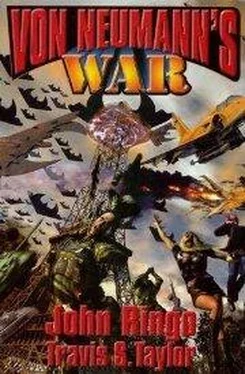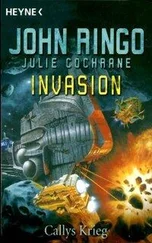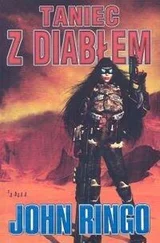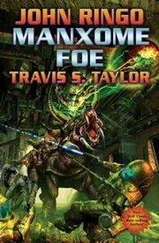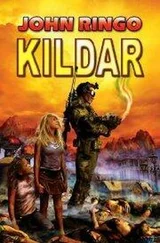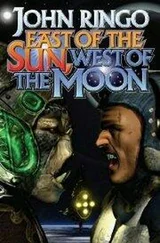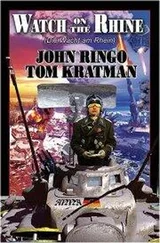“We sent Gries to France,” Roger argued.
“He wasn’t going in command of a group of shooters,” Danny said with a sigh. “He was an observer. That’s different. Lethal force and all that.”
“Danny, all we want to do is send ten guys or so to Greenland!” Roger said plaintively. “We’re developing the weapons and trap systems right now! What do we do, rent a plane?”
“It’s not that simple and you know it,” General Riggs said definitely.
“So what do I do?” Roger asked. “Call Ronny?”
“You don’t work for Ronny anymore,” the general pointed out. “And it’s not impossible to do, don’t get me wrong. But when you said ‘make your team larger’ you weren’t just talking about size, you were talking about profile, whether you know it or not. And you’ll be stepping all over a lot of feet.”
“I’ve been doing that since Alan, Tom and I came up with the mission, General,” Roger said, shrugging. “I’m not afraid to step on a few more. Who do I call, or whatever?”
“I know the way this is supposed to go,” the general said, breathing out. “But I’m not sure how to do it fast. Except make some calls. How can I reach you, Mr. Secretary?”
“On my cell?” Roger asked. “If it’s secure, I’ll move to one of the secure areas.”
“Right,” Riggs said, looking distracted. “Let me make a few calls. Who does Gries want?”
“I’ll send your secretary a list,” Roger said, standing up. “Thanks for your time, Danny.”
“Any time,” the general said, giving him a half salute. “Oh, what are you planning on using to catch these things?”
“The most incredible mish-mash,” Roger said, shrugging.
“Have you figured out how to track them yet?”
“I think, I dunno. I’m workin’ on it.” Roger raised an eyebrow Spock fashion. “The solution will be… fascinating.”
* * *
Roger had been analyzing the data from all previous engagements including the loss of the probes at the Moon and Mars and the telecommunications sats around Earth. And he agreed with Shane that radio was the culprit. If it was an emitter in the RF through to microwaves, it went first. That meant something, perhaps something even more sinister than he could put his fingers on and his mind around, but… but it was lingering in the back of his mind that there was more to the radio emission attraction than he had completely grokked.
What he had figured out was quite unfascinating technologically, but extremely fascinating from a “go figure” point of view. Roger had put together a team of electrical engineers and RF specialists including a group from the CIA’s Directorate of Science and Technology’s Measurement and Signatures (MASINT) division. He had also gathered some expertise from the NSA’s ELINT group and AFRL’s MASINT branch that used to be the so-called Central MASINT Office or CMO — the CMO had been renamed years ago, but it was still the CMO to Roger. And to round off his team he had found a group of wireless networking engineers and several amateur broadcasting enthusiasts. His team had been working for months behind the scenes trying to detect and even hack into the alien machines’ communications. Finally, one of the ELINT engineers found their communications method: Radio.
That sort of surprised people. Most of the group figured that it was some sort of unobtainium quantum whatchamacallit but it turned out to be, more or less, plain old radio.
More or less. Actually, it was a spread spectrum signal that worked a lot like 802.11b wireless data transmission protocol, only it was centered somewhere around 1.42 gigahertz. Roger could not place it but that particular radio frequency meant something to him.
After weeks of analysis they had a real good handle on the signal the bots used to communicate with each other. Centered at 1.42 gigahertz in the frequency spectrum there was a string of very fine bands — almost impulse functions with zero width — all of which were spread from the kilohertz all the way up to the terahertz. The frequency spike transmissions did not remain locked at the same frequency either. They randomly jumped from one frequency to the next along the many spikes that the bots used spread across the radio and microwave spectrum.
The unfascinating part was that spread spectrum technology was well understood and was a basis for ultra-wideband communications technology. The 802.11a, 802.11b, 802.11h, and 802.11g protocols used the technology, although their allocated spectrum was not as spread out as the ones the bots used.
The fascinating part was that the damned aliens used such a mundane technology that seemed so… so Earthly. Perhaps radio was a universal constant. After all, there were so many sources of RF in the universe that any advanced civilization should understand the technology quite readily. But, and the but here was significant, why would an interstellar traveling species limit themselves to speed of light communications? Perhaps the bots and their makers were limited to the speed of light limit. Once upon a time scientists would have said “Duh” to that pronouncement. For many decades the light limit was considered a hard and fast rule in physics. Recent theories, though, indicated that it might be possible to go faster than light, or at least to have FTL communications. But the alien probes still used radio. Perhaps it was a clue, and a good one if it was true, that the probes were not that much further advanced than humanity. Who knew?
Now if he could just figure out that unobtainium grabber field that Shane had noted.
What Roger did know was that they now had a way to track the bots’ movements. Hopefully, before long they might even be able to decrypt the hopping spectral broadcasts and therefore learn more about them. But the spectrum hopping sequence seemed basically random or at least more encrypted than anybody at the NSA and the CIA had ever seen. They kept trying, though; maybe, just maybe, somebody would figure it out.
* * *
“Hey, Major, Sergeant Major,” Alan said, waving them towards the covered range. “We’re still working on some of these weapons, but this is what we’ve got for you so far.”
Shane looked at the collection arrayed down the line and shook his head.
“They look like toys,” he said. “Or a redneck’s back yard.”
There was a weapon that looked vaguely like a bazooka with a magazine that was apparently constructed mostly of PVC and duct tape. There were two plastic rifles that clearly had ancestry in something bought at a local Toys R Us, and a covered object on the far end. Waiting by the weapons was a large person Shane hadn’t met yet. Very large. He both overtopped Cady and outweighed him. The guy was a fucking mountain with black, shaggy but short hair, massive hands and shoulders, and a long, lugubrious face. He looked like Abraham Lincoln on a bad day.
“Well, that’s what they is, Major,” the man said in a slow Cajun drawl. “We’uns done did the best job we could with the time we got. When you guys go we’un gonna give you better stuff. But this is what you might call the prototyping period.”
“Major Shane Gries, Sergeant Major Thomas Cady,” Alan said, waving at the two soldiers. “Doctor Phillip Krain, Ph.D. Lurch, Shane and Cady.”
“Pleased to meet you, Major,” the man said, slowly reaching out and shaking his hand. The Ph.D.’s paw absorbed Shane’s.
“Pleased to meet you, Doctor,” Shane said, realizing that if the guy wanted to rip his arm off he was going to be going around the rest of his life with a stump. “You’re a…”
“My specialty’s chemistry,” Krain said, shaking Cady’s hand as well. “Exothermic reactions.”
“He’s really good at getting things to blow up,” Alan translated.
Читать дальше
